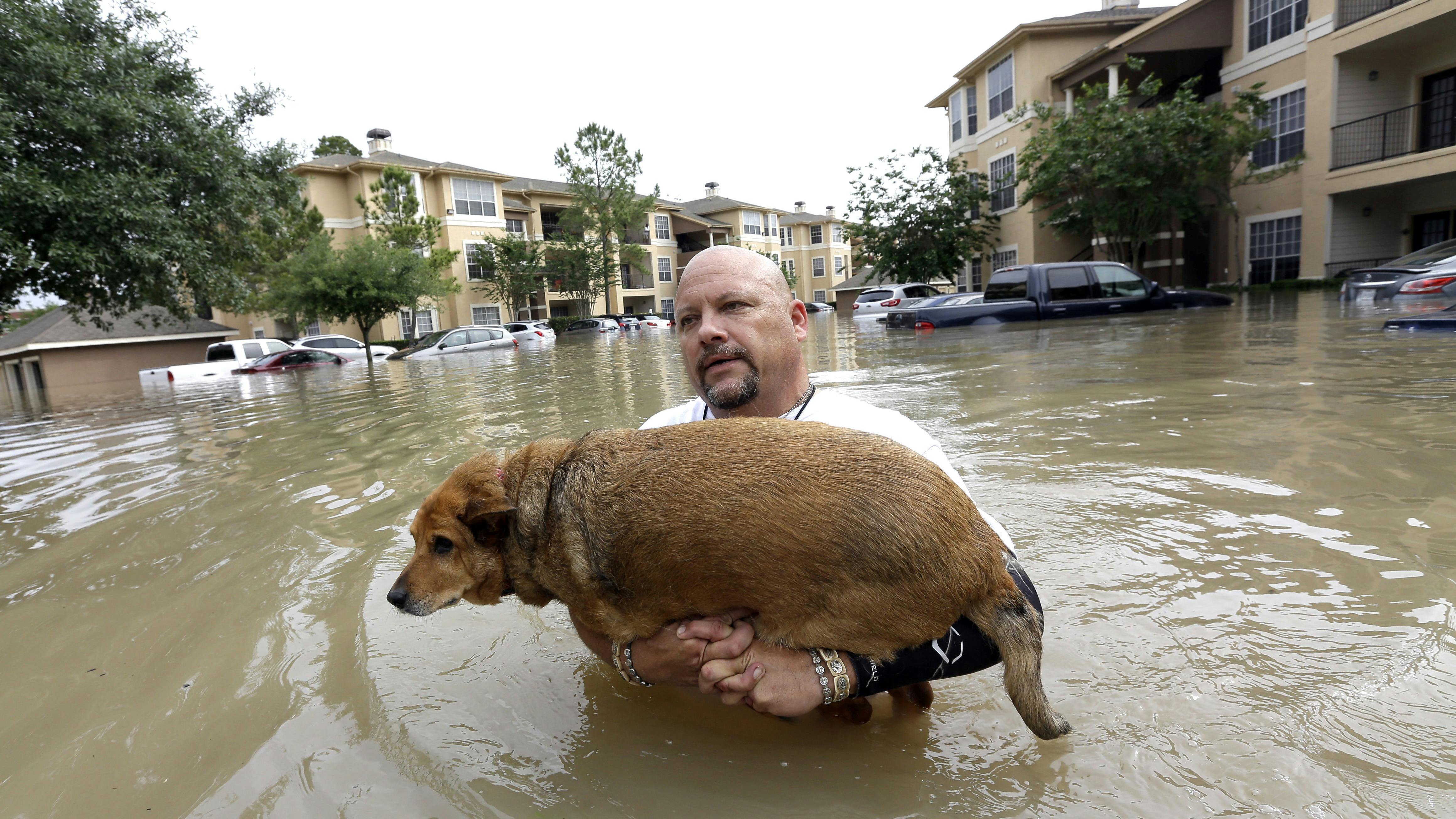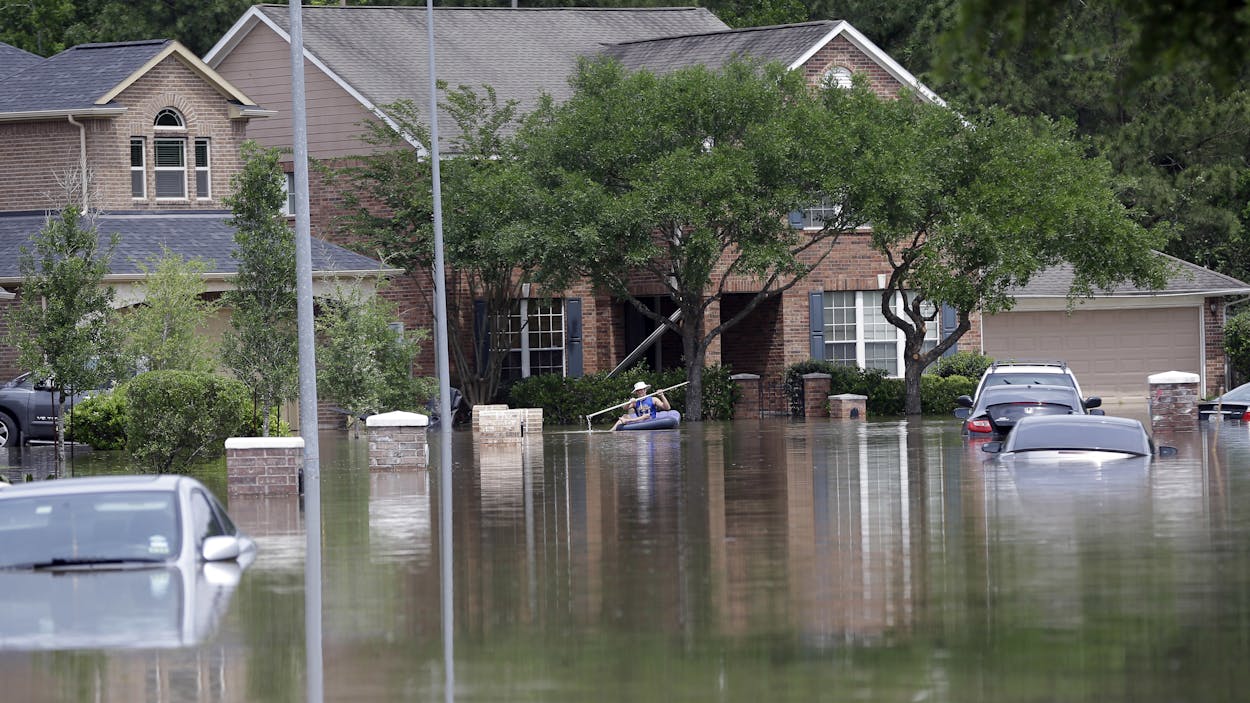It has been one week since Houston’s second historic flood in as many years, and now that a slew of postmortems are in, you can’t help but ponder one rather large question: is Houston, as we know it, sustainable? Opinion article after opinion article has posed this question in one form or another, but there doesn’t seem to be any definitive solution.
Some wonder if America’s most laissez-faire big city can keep on keepin’ on with its unchecked sprawl, its miles of paved roads and strip-mall parking prairies, and gated communities of lot-covering McMansions eight feet apart.
Well, strip mall developer Ed Wulfe seems to think so. Houston just needs a helping hand from Uncle Sam:
“It is obvious that we have not designated our city’s infrastructure to meet those needs. Our elected city, county and national officials need to come together to energize our federal government to address our flooding issues in the same way and with a similar amount of funding as devoted to the Sandy storm on the east coast, Katrina in New Orleans and others.”
Others see developers like Wulfe as a big part of the problem. This time around, far west and far northwest Houston bore the brunt of the rain, with those downstream suffering from run-off many believe to be exacerbated by overdevelopment of the prairies west of town. The Bayou Land Conservancy, in fact, says that filling the wetlands has “directly” resulted in an increase of flooding:
When wetlands are allowed to function, they’re the kidneys of the area’s watershed. Their special soil types are surrounded by particular wetland plants that help hold water in shallow depressions. They clean the water as they allow some of it to filter slowly into the ground, the rest to drain slowly into our bayous. That process is the foundation of our region’s ecology.
The rampant destruction of our forested and prairie wetlands is upsetting this balance, drastically reducing the land’s ability to absorb water. By allowing so many wetlands to be turned into subdivisions, we’re not just kicking them to the curb; we’re turning them into curbs. We need the ecological equivalent of dialysis.
So Houston’s undergoing kidney failure just in time for heavier downpours brought on, some believe, by climate change. And will Houston just wring itself out and hope that another monsoon doesn’t come its way until we’ve forgotten about this one? Shouldn’t we have done more to address this in the flush times of $100 oil just past? Bruce Nichols, a retired journalist who focused on urban trends, seems to have had enough with this cyclical failure:
We have a history of failing to leverage boom-time prosperity to improve land-use regulation and infrastructure planning to solve these problems. Then, when busts come, we say our hands are tied because we need growth at any price.
This is foolish, and I think stems partly from Houston’s historic sense of inferiority, the mindset that we somehow are not good enough to have a better quality of life. Dallas-Fort Worth and Austin have stronger planning and regulation, and they seem to be doing just fine.
And speaking of growth, can Houston absorb the 3.8 million new inhabitants it is forecast to gain over the next 24 years? Nobody thinks building in a floodplain (100-year or 500-year or any-year) is a good idea. But where, if not floodplains, are those projected newcomers supposed to go? On the other hand, given that the city is facing a $5.6 billion, Chicago-sized municipal pension crisis, can Houston afford not to add all those millions of new taxpayers?

These are all tough questions, but maybe not insoluble ones. The Chronicle, and especially the Gray Matters blog, offered a shotgun blast of remedies, some of which I will pose as devil’s advocate against.
Density
David Crossley, founder and senior fellow at think tank Houston Tomorrow believes Houston can, at least in part, densify its way out of this mess. He contends that even large apartment buildings render less terrain impermeable than sprawling suburban developments.
But Houston can’t click its heels together three times and turn into Manhattan. To bring Crossley’s vision to reality, the city will need to greatly enhance its public transit system, better maintain its sidewalks and alter more of its onerous, suburban-style parking ordinances, all of which—in their current state—conspire to make Houston pedestrian-unfriendly, flood-prone, and sprawling.
Architecture
John Jacob thinks that, in addition to building outside of floodplains, pre-World War II-style building designs such as raised, pier-and-beam foundations (as opposed to flat slabs) and raising homes a few extra feet above sea level with dirt dredged from the Ship Channel. But pier-and-beam constructions are far more expensive than slab houses.
Eco-Friendly
Outgoing Bayou Land Conservancy head Jennifer Lorenz had more eco-friendly suggestions, including planting millions of trees, as each mature tree is capable of lifting 100 gallons of water out of saturated soil and converting it into air. She also advocated that homeowners replace slow-runoff but wildly popular St. Augustine grass with native grasses and plants, enforcing rules against developers who tend to skate from their retention pond requirements via developer-friendly loopholes, foregoing plastic bags and single-use water bottles (as they tend to wind up in and clog storm drains), and to treasure—rather than destroy—our wetlands. She wrote:
Stop thinking of preserving wetlands as a drag on our economy. It’s the opposite. “Green space is green space,” says Harris County Pct. 4 Commissioner Jack Cagle, “both ecologically and economically. Economically it provides an attractive draw to businesses who want good places to work and for their employees. It also economically protects those same businesses and their employees’ families when the waters rise.”
But that brings up another big question that affects both flood prevention planning and life as Houston knows it: are Houstonians running out of space, both green and asphalt-gray?
*Correction: An earlier version of this article misstated John Jacob’s quotes from another interview. We regret the error.







